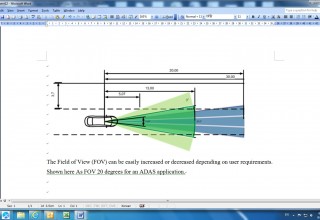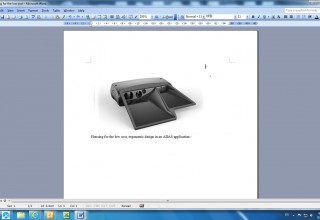Aerostar Unveils Its Unique Compact LIDAR Multi-sensor Pedestrian and Obstacle Detection Technology
The unique proprietary LIDAR obstacle detection technology is especially suited for all ADAS functions with a focus on pedestrian detection and avoidance.
Online, October 21, 2013 (Newswire.com) - After years of development, Aerostar proudly unveiled today its unique compact LIDAR reference design. Used for the detection of obstacles and evaluation of their range in real-time, the reference design uses multiple independent detectors, covering a horizontal field of view (FOV) exceeding 20 degrees and a vertical FOV of 12 degrees. Using an eye and skin safe laser operating at 905nm and housed in a low cost, self-contained, ergonomic design, this specific configuration is particularly adapted to the detection of obstacles on platforms navigating at low to medium speeds from 0 to 70mph.
This powerful, cost-effective and programmable DSP-based sensor, completed by a Linux Kernel, can easily be adapted to a range of applications that need to detect obstacles or evaluate the range profile of a relatively large field of view instantaneously. The exclusive LIDAR technology developed by Aerostar, using no moving parts, is robust and provides refresh rates at up to 100Hz, making it suitable for high-velocity platforms as well.
The configurable optics can be modified to increase the range of the current reference design, or to adapt the FOV to customer requirements. For specific applications, range and detection capacity will depend on placement, transmission medium, as well as the FOV selected for the application, but the flexibility of this platform opens up enormous potential applications. For example, if a client requires a 360 degree FOV, the platform can be expanded by simply adding more sensors or conversely, if a client requires a more limited FOV, the number of sensors, and the cost, can be reduced.
In recent testing, Aerostar successfully demonstrated an automotive ADAS application, capable of detecting automobiles at a range of 30 meters, even when placed behind the windshield, which is known for very poor infrared transmission. Detection of pedestrians and other small non-cooperative obstacles (letterboxes, trees etc) was proven above 25 meters using the wide FOV of the reference design in an open air setting. The sensor is also designed to perform well in poor visibility conditions and through obscurants such as rain, smog, smoke and dust. In the recent test (pictured below), pedestrian detection was not hampered by moderate rainfall.
Although mono or stereo cameras are currently used for many ADAS applications and do perform well, they lack the precision and distance coverage of LIDAR. In particular, in poor visibility conditions like fog, darkness, direct sunlight, opposing headlights, pedestrians in dark clothes and multiple vehicles, camera applications fall short on performance. But when Aerostar's LIDAR is combined with camera and video appplications, many of these obstacles can be mitigated or overcome. With this type of performance, in the short term the system can provide extremely accurate ADAS and in the long term, could play a major role in autonomous driving.
With dimensions of approximately 15.5cm x 7.5cm x 4cm and very low power consumption, the Aerostar LIDAR platform while designed and proven for automobiles ADAS , can be utilized for obstacle avoidance on a variety of small navigation platforms, such as mobile robots, UAVs and industrial equipment. The platform, unlike most past LIDAR-based detection systems, is readily available for simple go/no go -type testing by the end customer and is very scalable for cost-effective mass production.
For more information, contact Stephen at (516) 677-5390 or stephen@aerostarusa.com.



